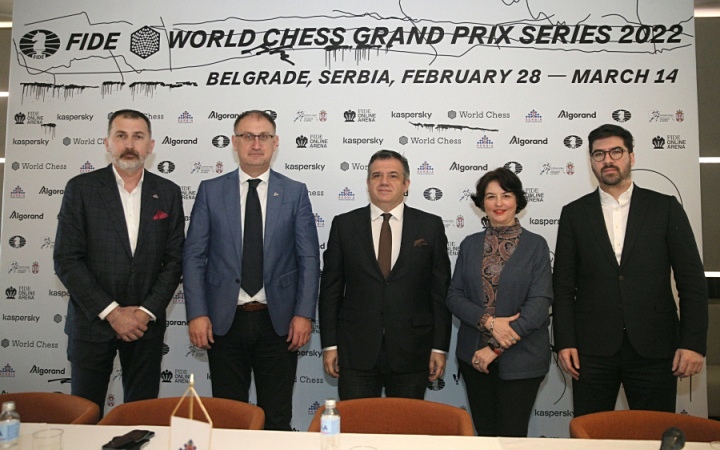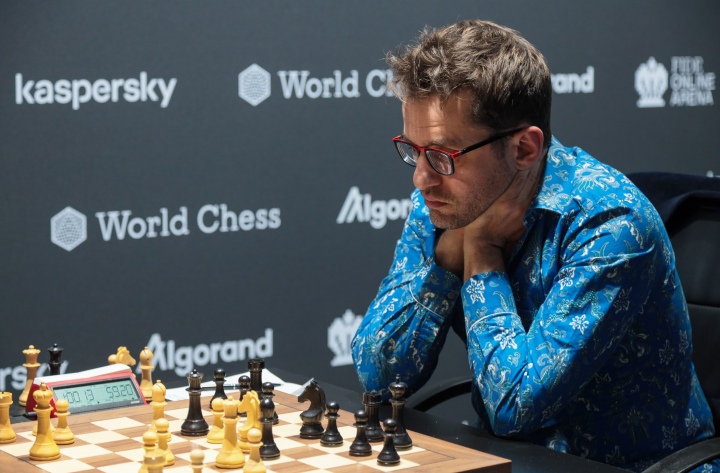Media warm-up for FIDE Grand Prix held in Belgrade

Scores of reporters and media crews show up for the media ‘warm-up’ event, showing how eagerly the tournament is anticipated in Serbia. Ahead of the second leg of the World Chess Grand Prix, which will take place in Belgrade (Serbia) between the 28th February and 14th March, the Chess Federation of Serbia organised a ‘warm-up’ event for the media. A significant number of journalists from Serbia and the region who turned up reminded how important and popular the 64-square game is in this once great chess country. The media event started with a short video depicting the historic chess tournaments and figures who visited, played or were born in Yugoslavia. Previously the capital of the mighty chess nation, it has been decades since the region has been home to a major chess event involving many of the world’s strongest players. The anticipation of the Grand Prix tournament has already attracted a lot of public interest, and the Serbian government has pledged its support for the event. Speaking at the media conference in Belgrade’s Crowne Plaza Hotel (where the tournament will be played), Alisa Maric – once one of the strongest world female Grandmasters – said that she is very happy as, after many decades, Serbia will once again play host to the chess elite. “This tournament is taking us back to the old times when the best players from all over the world came and played here. I hope that this is just the beginning and that this event will also serve as motivation to our own young players to strive forward and flourish.” The President of the Chess Federation of Serbia, Dragan Lazic, expressed his gratitude to FIDE for entrusting Belgrade to host one of the Grand Prix events: “Serbia has not hosted such a big event since the 1990s. I believe that this is just the first step towards achieving our ambition – for Serbia to be the host of a Chess Olympiad.” Lazic added that the organisers would do everything to ensure that the players enjoy their time here, have excellent playing conditions and feel safe and comfortable. Support for the event is also provided by the Serbian government. Belgrade deputy mayor, Goran Vesic, stressed the importance of the event for Serbia – its image, chess tradition and culture. Vesic said that the government would consider how to further increase and improve chess programs in schools and make them part of the curriculum. The 2022 FIDE Grand Prix, a part of the world championship cycle, consists of three tournaments. The tournaments take place in Berlin (Germany) and Belgrade (Serbia) between February and April 2022. The two top performing players in the Grand Prix will qualify for the 2022 Candidates Tournament in Madrid (June-July). Text: Milan Dinic Photo: Marko Metlas/Alo!
FIDE Grand Prix: Levon Aronian, first semifinalist

The last round will decide the other three spots. IM Michael Rahal – Berlin, February 9th 2022 – Today’s round in the Berlin Grand Prix began with a bit of drama. The President of the German Chess Federation, Ullrich Krause, had been invited to execute the first “ceremonial” move on GM Vincent Keymer’s board. However, while fifteen of the sixteen players were already firmly seated, most of them fully concentrated, Keymer’s opponent – GM Levon Aronian – had yet to appear. The signs of relief on Chief Arbiter Ivan Syrovy’s face when Aronian finally stepped into the playing venue at exactly 14.59 were clearly visible. The former Armenian player, now representing the USA, greeted his opponent and awaited 1.d4, in this case, played by Krause, and the round was on. And an exciting round it was! Four wins and four draws in an eight-player round-robin is a remarkable statistic. In addition, Aronian’s win over Keymer qualifies the USA competitor to the semifinals, while Esipenko and Dominguez scored important wins with Black that allow them to keep their qualifying chances intact for tomorrow’s final round. Pool A Trailing Hikaru Nakamura by half a point, but playing Black, Alexander Grischuk had a really difficult task ahead of him. His opening choice, the double-edged King’s Indian Defence, definitely seems the way to go to fight for a win. However, after Nakamura’s 6.Be3 – the Semi-Averbakh variation, a fitting choice as the legendary Russian Grand Master turned 100 yesterday – Grischuk plunged into deep 15-minute thought. He finally decided to follow the main line but around move twenty, he was already down to his last twenty minutes, a startling contrast to Nakamura’s one hour twenty. At the critical moment, Nakamura transferred his bishop to b2, zeroing in on Grischuk’s king, already weakened on the dark squares thanks to an early h-pawn push by the American. With hardly any thinking time and facing a direct attack, the Russian buckled under the pressure – his position crumbled, leaving Grischuk out of the race for qualification. Asked by Press Officer Michael Rahal what could he take away from the game, his reply, as usual, wasn’t disappointing: “I probably have to stop playing the King’s Indian”, finding some light humour in a desperate tournament moment. In the other game of the A-pool, Andrey Esipenko had no other chance but to shoot his last bolt to defeat the last-placed competitor of the group, Etienne Bacrot. He was probably going to play the Marshall Attack, but Bacrot nipped that idea in the bud, deciding on a solid anti-Marshall line with a rapid exchange of queens. The game remained mainly balanced until Bacrot played 27.Bc4. Esipenko grabbed the chance to plant his rook on d4 and began to advance his kingside pawns, eventually creating a passed g-pawn that ultimately decided the game in his favour. In his postgame interview, Bacrot said that he had been quite lazy in his calculations and should never have fallen into this passive endgame position. Esipenko was obviously very happy with the outcome and will now have White against Nakamura in the last round: whoever wins will qualify to the semifinals, but Nakamura also advances with a draw. Pool B The first game of the afternoon to finish was a quick affair. Playing with White against the co-leader of the group, Radoslaw Wojtaszek decided to play it safe. Slightly surprised by his opponent’s opening choice, Radek recognized in the postgame interview that he had missed 18…Rc4 and that he even thought that he was slightly worse, given which he decided to initiate mass exchanges leading to a three-fold repetition in a completely level position. Although Vladimir Fedoseev still has to face (with White) Rapport in the last round, his solid opening choice clearly indicates that a draw was a good result for him today. Meanwhile, in the other game, Grigoriy Oparin repeated the Tarrasch variation he already played in the third round. When the pawn structure stabilized, he found himself with another isolated d-pawn position which he seems to enjoy defending: a weak pawn but in exchange for active piece play. However, when things seemed to be going well for Richard Rapport, he missed 23…Ng3 and had to take on the defensive. Oparin started piling on the pressure and gradually increased his advantage in the endgame. On move 41, just after the time control, Oparin missed a great opportunity to win on the spot with 41…Re2+ before capturing the pawn on f2. In the postmortem on the board, both players thought that it was a draw, but further analysis seemed to confirm the win for Black. These results leave everything open for the last round: a very exciting and interesting tournament situation where the winner of the game between Fedoseev and Rapport could easily win a spot in the tiebreaks. Pool C Possibly inspired by the President of the German Chess Federation’s first move, Vincent Keymer went all-out for Aronian’s throat in today’s game. Trailing the leader by two points but playing with the white pieces, Keymer went for a crazy pawn-grab in the solid Ragozin Defence (13.Nxe5 instead of the prudent 13.0-0), allowing his opponent to force his king into the center with hardly any protection. An unrelenting battle began, with players attacking with heavy shots such as 17.g4, 17…g5 and 18.b4. Computer analysis indeed confirmed that the players were finding the best moves, but White’s position seemed to be always hanging by a thread. Things remained tactically balanced until Keymer blundered big with 29.Rh5? (29.f3 was still equal according to the computer). Aronian seized the moment, capturing the two center pawns, and the game was over. In the postgame interview, both players mentioned that they had analyzed the position after 13.Nxe5 some time back, but it was hard to remember the various lines. In the other game of the group, both Vidit Gujrathi and Daniil Dubov, tied on two points out of four, faced their last opportunity to win a full point and catch Aronian. A Tarrasch defence transposed into a sideline of the Queen’s Gambit Accepted. Although Dubov declared that he had spent the

